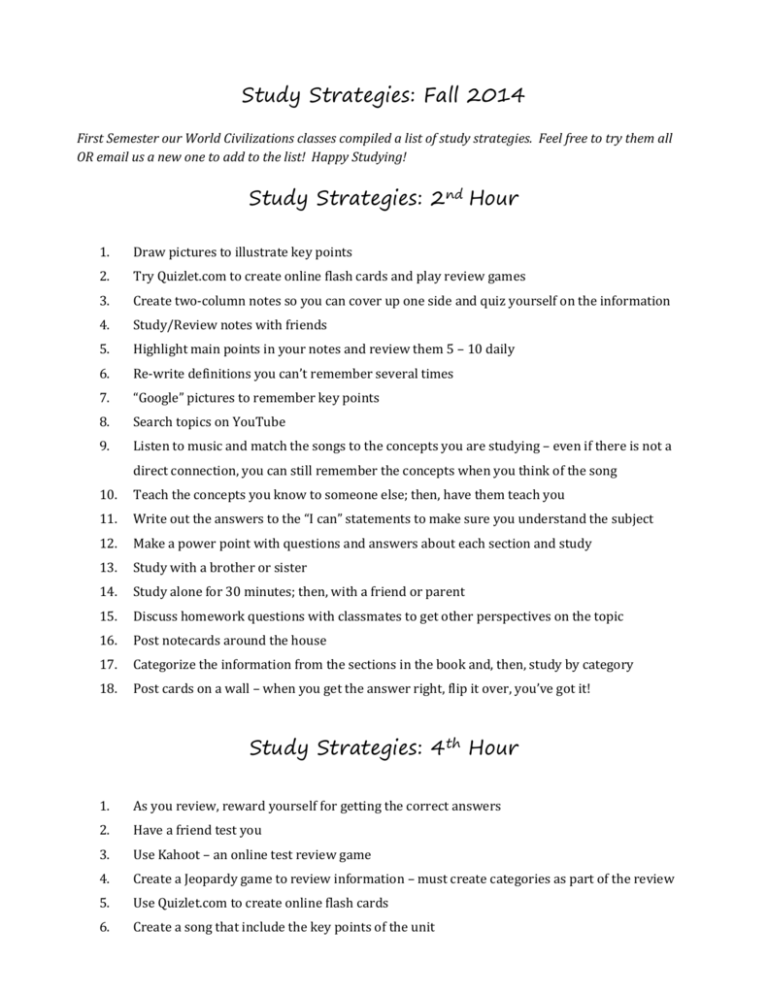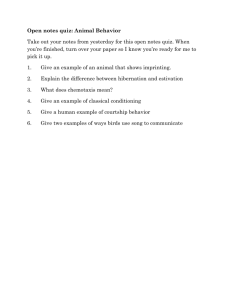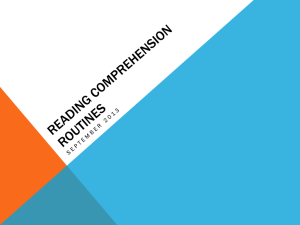Study Strategies: Fall 2014 First Semester our World Civilizations
advertisement

Study Strategies: Fall 2014 First Semester our World Civilizations classes compiled a list of study strategies. Feel free to try them all OR email us a new one to add to the list! Happy Studying! Study Strategies: 2nd Hour 1. Draw pictures to illustrate key points 2. Try Quizlet.com to create online flash cards and play review games 3. Create two-column notes so you can cover up one side and quiz yourself on the information 4. Study/Review notes with friends 5. Highlight main points in your notes and review them 5 – 10 daily 6. Re-write definitions you can’t remember several times 7. “Google” pictures to remember key points 8. Search topics on YouTube 9. Listen to music and match the songs to the concepts you are studying – even if there is not a direct connection, you can still remember the concepts when you think of the song 10. Teach the concepts you know to someone else; then, have them teach you 11. Write out the answers to the “I can” statements to make sure you understand the subject 12. Make a power point with questions and answers about each section and study 13. Study with a brother or sister 14. Study alone for 30 minutes; then, with a friend or parent 15. Discuss homework questions with classmates to get other perspectives on the topic 16. Post notecards around the house 17. Categorize the information from the sections in the book and, then, study by category 18. Post cards on a wall – when you get the answer right, flip it over, you’ve got it! Study Strategies: 4th Hour 1. As you review, reward yourself for getting the correct answers 2. Have a friend test you 3. Use Kahoot – an online test review game 4. Create a Jeopardy game to review information – must create categories as part of the review 5. Use Quizlet.com to create online flash cards 6. Create a song that include the key points of the unit 7. Play Hangman to review vocabulary terms 8. Create a rhyme to remember key points 9. Stay organized and focused! 10. Create a Memory Game – word, then find definition 11. Two-Column notes 12. Pre-quiz 13. Discussion group/study group 14. Re-read notes and re-write key points 15. Trivia game Study Strategies: 6th Hour 1. Study different subjects in different rooms (ex. Study Chinese philosophers in the Kitchen and the Persian Wars in the Family Room) 2. Summarize key points using the “snip method” – re-read and paraphrase main ideas 3. Sample Quest Prep Schedule: Monday: Study 10 to 15 minutes Tuesday:Study 15 – 20 minutes Wednesday: Study 20 – 25 minutes Thursday: Study 25 – 30 minutes Friday: Earn an “A” on the quest *Be sure to study the stuff you DON’T know, NOT the information you DO know 4. “Phone a Friend” Strategy – Call friends and talk to them about what they know and share what you know 5. Study with family 6. Create and play a review game 7. “Guess that Picture” Review Game 8. Reward yourself as you study – know the significance of the Battle of Marathon? Eat a KitKat! 9. Use the “Gummy Bear Technique” – place gummy bear at the end of each paragraph in the book. When you finish the paragraph, enjoy the gummy bear! 10. Create a “Big Boy (or Girl) History Crossword Puzzle” online 11. Set a time to study…and stick with it! 12. Create a song that summarizes your notes/big ideas 13. Study with a partner OR organize a study group 14. Create a practice test (model questions after previous tests) 15. Create Two-Column Notes – terms on one side, their importance on the other – fold in half to quiz yourself 16. Make a jump rope rhyme 17. Use an online quiz resource 18. Color-code information 19. Study Breaks! 20. Have someone else make a test for you Study Strategies: 7th Hour 1. Charades (act out key concepts) 2. Use an online quiz resource 3. Ask parents to quiz you 4. Create a song that summarizes the topic 5. Design a pre-test (be sure to model test questions after past test questions) AND take it! 6. Study questions and answers and gradually add more time in-between asking yourself the questions and checking the answers 7. Create Two-Column Notes – terms on one side, their importance on the other – fold in half to quiz yourself OR questions on one side, answers on the other 8. Two-Column, 3 color Study Guide – questions on one-side, color-coded answers on the other (ex. Blue Answers – you know REALLY well; Purple Answers – you had to go back to your notes/book to find; Red Answers – corrections/additions) 9. Track what you know and don’t know in a Venn Diagram – re-write the information you don’t know or kind of know at least three times so you know it really well 10. “Pictionary” – draw a picture to represent key concepts 11. Color Code Notes 12. Design a timeline to track important events/cause and effect 13. Create funny connections to the content to help you remember main ideas 14. Make your own study guide 15. Create images or phrases that connect to the information





